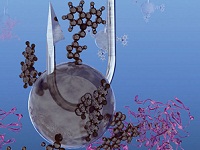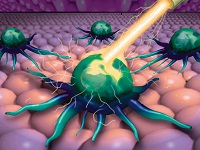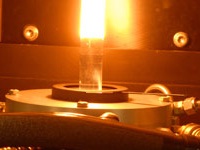how to stop an atom
stories and images by Neil Caudle
To make his cool tools, Lin Zhu thinks small as an atom and big as the reaches of space.
Sooner or later, technology’s pursuit of ever-smaller devices leads it down the rabbit hole and into the realm of quantum mechanics, where the hot dance of atoms makes assembling tiny structures iffy. Theoretically, you could stop the atoms cold at absolute zero (minus 459.67 degrees Fahrenheit) and configure them as needed, but doing so appears to be a practical impossibility. Even if you could a find a freezer with that kind of chilling power, moving anything around inside it would excite a few atoms and set them to dancing again.
 In his quest for tiny devices, Lin Zhu explores ways to control an atom by freezing it, not with cold but with lasers.
In his quest for tiny devices, Lin Zhu explores ways to control an atom by freezing it, not with cold but with lasers.Oddly enough, the solution may turn out to be lasers, which most of us associate with heat, not cold. In the right conditions, an atom, like a deer in the headlights, will freeze in the beam of a laser. This is a virtual freezing—the effect of absolute zero without its big chill. And the use for such a thing? Lin Zhu imagines, for example, the tiniest of engineered bridges, a nanobridge, holding a single photon. Bridges can also become switches, open or closed—the makings of a circuit.
Zhu, a quiet, unassuming man, is reluctant to talk about this part of his work, because it involves fundamental science too theoretical to have an obvious application, at the moment. He does not expect us to follow him down the rabbit hole. But he keeps an eye on the quantum realm as he develops his devices, which are mostly diode lasers.
If you’ve ever used a laser pointer to tease the cat or highlight a bit of data in your slide presentation, you aimed a laser diode, a compact and highly efficient technology for converting electricity into light. The typical laser pointer is rated at about five milliwatts, five one-thousandths of a watt. But it is potent enough, if flashed into the sky, to distract a pilot, which is against the law.
Zhu is working on diode laser arrays that could reach several watts for a single emitter or up to two hundred for an array—intensely bright lasers strong enough to pump other lasers, cut metal, power a laser radar system, or beam information from satellites in space. To approach that level of intensity, Zhu assembles several emitters, each about the diameter of a human hair, onto a tiny bar and merges their beams into one. He also battles one of the diode laser’s most notorious limitations: the loss of beam quality as the power goes up.
 Zhu’s diode lasers protrude like tiny needles from their mounting hardware. The lasers are about 1 millimeter long and 0.1 millimeter thick.
Zhu’s diode lasers protrude like tiny needles from their mounting hardware. The lasers are about 1 millimeter long and 0.1 millimeter thick.“At high power the beam quality is not very good because there are too many modes being generated inside the optical cavity of the laser,” Zhu says. The modes are diffracted waves of energy inside the cavity, and they can bounce around out of control. Engineers have tried to correct the problem by using lenses to focus the light as it comes from the diode. Zhu hopes to eliminate the need for a lens by improving the optical cavity itself. He and his students design and fabricate gratings—zigzagged microstructures designed to corner and control the diffractions.
But increasing the power of diode lasers is not Zhu’s only goal. He is also finding ways to build biodetectors. Imagine a device, perhaps built into your cell phone, that could alert you to contaminants wherever you went. People already use lasers for biodetection in laboratories, where the sweep of light through a sample of liquid creates wavelengths a sensor can read like a fingerprint. But the setup is bulky, because the lasers are separate from the sample and detector.
“What we’re trying to do is to integrate the laser, the sensor, and the detector on a single small chip,” Zhu says. “This would let you take the detector almost anywhere.” In this case, the technology would be measured not so much by its wattage as by the smallest possible space required to hold a big idea.
This is what Eric Johnson has to explain, outside of work. But what he does make, with his team of savvy students, takes vision.
His was not the usual path to a job fighting cancer. Stephen Foulger was a California dude, a surfer and gear head who built motorcycles.
Sung-O Kim came to COMSET to work on displays and wound up taking aim at cancer. Not that cancer is the lab’s only target.
Fiber optics spread the Internet around the globe, but the science of light is just warming up. Go back to Material advantage and the power of light.
For now, we can introduce you to only a few of the people at COMSET, and we’ll have to save a number of researchers for issues to come. Or visit the COMSET website.
Lin Zhu is the Warren Owen Assistant Professor of Electrical and Computer Engineering in the College of Engineering and Science. His research is funded primarily by the Department of Defense and by the National Science Foundation.








